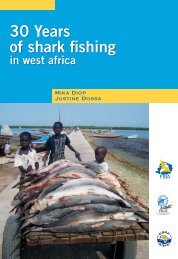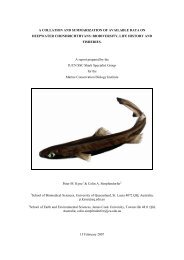Magazine of the species survival Commission specialist Group - IUCN
Magazine of the species survival Commission specialist Group - IUCN
Magazine of the species survival Commission specialist Group - IUCN
You also want an ePaper? Increase the reach of your titles
YUMPU automatically turns print PDFs into web optimized ePapers that Google loves.
<strong>species</strong> programme update<br />
Freshwater Biodiversity Unit (FBU)<br />
African Freshwater Biodiversity Assessment<br />
completed<br />
Following six years <strong>of</strong> hard work, involving nearly 200 regional<br />
and international scientists, more than 5,000 <strong>species</strong> <strong>of</strong><br />
freshwater fish, molluscs, crabs, dragonflies and damselflies,<br />
and aquatic plants were added to <strong>the</strong> <strong>IUCN</strong> Red List in<br />
September 2010. This more than doubles <strong>the</strong> number <strong>of</strong><br />
freshwater <strong>species</strong> previously assessed, in <strong>the</strong>se taxonomic<br />
groups, and includes almost all known freshwater <strong>species</strong><br />
across continental Africa. One in five <strong>species</strong> is currently<br />
threatened and <strong>the</strong> future looks bleak given <strong>the</strong> huge scale <strong>of</strong><br />
planned development <strong>of</strong> Africa’s inland wetlands in <strong>the</strong> coming<br />
years. We are hoping that this data set will be applied to help<br />
avoid or minimize <strong>the</strong> impacts <strong>of</strong> such developments. These<br />
results were publicized through a press release on<br />
2 September, and Will Darwall presented <strong>the</strong> main findings at<br />
<strong>the</strong> 2010 World Water Week in Stockholm. A detailed syn<strong>the</strong>sis<br />
<strong>of</strong> <strong>the</strong> main findings is available on <strong>the</strong> <strong>IUCN</strong> Red List website<br />
under <strong>the</strong> Freshwater Initiatives pages. Reports summarizing<br />
results at <strong>the</strong> regional scale have now been published for<br />
Eastern, Sou<strong>the</strong>rn, Western, Nor<strong>the</strong>rn and Central Africa. We<br />
are submitting a scientific paper presenting <strong>the</strong> main project<br />
findings in <strong>the</strong> context <strong>of</strong> <strong>the</strong> importance to local livelihoods,<br />
improved knowledge for conservation planning, and as an<br />
important information source for input into development<br />
planning in Africa’s Green Revolution. We are also producing a<br />
final syn<strong>the</strong>sis <strong>of</strong> all results at <strong>the</strong> continental scale, which will<br />
be published in 2011.<br />
Findings <strong>of</strong> <strong>the</strong>se biodiversity assessments are being<br />
imputed into environmental planning at four sites: <strong>the</strong><br />
Okavango Delta (Botswana); Rusizi Delta (Tanzania); Gambia<br />
River (Senegal); and <strong>the</strong> Moulouya River Basin (Morocco).<br />
These case studies develop and demonstrate <strong>the</strong> processes<br />
for taking <strong>the</strong> results <strong>of</strong> biodiversity assessments forward to<br />
directly inform development and conservation planning.<br />
Reports on <strong>the</strong> findings <strong>of</strong> each project will be available<br />
in 2011.<br />
Expansion into Asia<br />
The four major freshwater <strong>species</strong> assessment projects in<br />
Asia are progressing well. The Eastern Himalayas Hotspot<br />
project report is due for release in December 2010, and all<br />
assessments were submitted to <strong>the</strong> <strong>IUCN</strong> Red List for <strong>the</strong><br />
October 2010 update. The review workshop for <strong>the</strong> Western<br />
Ghats was held in early October in India, hosted by <strong>the</strong><br />
project partner Zoo Outreach Organization. The Indo-Burma<br />
Hotspot project has been granted an extension to May 2011<br />
when <strong>the</strong> assessments will be submitted to <strong>the</strong> Red List.<br />
Review workshops for <strong>the</strong> Indo-Burma assessments will be<br />
held in late January 2011 in Sou<strong>the</strong>ast Asia. The review <strong>of</strong><br />
<strong>species</strong> assessed through <strong>the</strong> HighARCS project has been<br />
combined with workshops for <strong>the</strong> Indo-Burma and Eastern<br />
Himalayas projects.<br />
Results from <strong>the</strong>se assessments, covering approximately<br />
4,000 <strong>species</strong> representing all known <strong>species</strong> <strong>of</strong> freshwater<br />
fishes, molluscs, Odonata and selected families <strong>of</strong> aquatic<br />
plants in <strong>the</strong> region, will be published in late 2010 (Eastern<br />
Himalayas) and in 2011.<br />
Toolkit for Integrated Assessment <strong>of</strong><br />
Wetlands<br />
An Integrated Wetland Assessment Toolkit: A guide to<br />
good practice published in July 2009 is currently being used<br />
by <strong>the</strong> HighARCS project to design <strong>the</strong> field surveys <strong>of</strong> five<br />
communities in highland areas in India, China and Viet Nam<br />
to help assess <strong>the</strong> biodiversity, livelihood and economic value<br />
<strong>of</strong> wetlands that <strong>the</strong>se communities rely upon. It is also being<br />
used by WorldFish to inform fisheries and livelihoods<br />
management work in China, and Wetlands International may<br />
also use <strong>the</strong> publication for <strong>the</strong>ir work in Sou<strong>the</strong>ast Asia.<br />
Key Biodiversity Areas (KBAs)<br />
Based on previous work carried out by <strong>the</strong> FBU, finalized<br />
criteria for <strong>the</strong> identification <strong>of</strong> freshwater KBAs have been<br />
produced and are being tested using newly available data<br />
from <strong>the</strong> pan-Africa assessment. As part <strong>of</strong> this process we<br />
contributed a list <strong>of</strong> potential freshwater KBAs, and some<br />
initial prioritization work was conducted using conservation<br />
planning s<strong>of</strong>tware (MARXAN) at a workshop run by<br />
Conservation International in sou<strong>the</strong>rn Africa, which was<br />
aimed at producing a list <strong>of</strong> candidate freshwater KBAs for<br />
<strong>the</strong> region. Will Darwall presented preliminary results and<br />
organized a discussion meeting to present <strong>the</strong> finalized<br />
criteria and initial analysis at <strong>the</strong> 2010 SCB Symposium<br />
in Alberta.<br />
BioFresh<br />
The FBU is in a partnership with an European <strong>Commission</strong>funded<br />
project called BioFresh to build an information portal<br />
to enable research on <strong>the</strong> main drivers <strong>of</strong> freshwater<br />
<strong>species</strong> distributions, predicted future <strong>species</strong> distributions,<br />
and much more. With <strong>the</strong> availability <strong>of</strong> <strong>the</strong> pan-Africa dataset<br />
<strong>the</strong> team has been analyzing broad-scale patterns in<br />
freshwater biodiversity across Africa, and examining how well<br />
<strong>the</strong> existing protected areas network represents freshwater<br />
<strong>species</strong> <strong>of</strong> conservation concern. Look out for <strong>the</strong> results in<br />
<strong>the</strong> coming months. See <strong>the</strong> project website:<br />
http://www.freshwaterbiodiversity.eu/<br />
Red List Website<br />
There have been three updates <strong>of</strong> <strong>the</strong> <strong>IUCN</strong> Red List since<br />
May this year:<br />
<strong>IUCN</strong> Red List version 2010.2: This, <strong>the</strong> second<br />
update <strong>of</strong> <strong>the</strong> year, was released on 29 June. The main<br />
focus <strong>of</strong> this update was <strong>the</strong> inclusion <strong>of</strong> assessments for all<br />
known mangrove <strong>species</strong>. Keeping to <strong>the</strong> aquatic <strong>the</strong>me,<br />
this update also brought in regional assessments for 454<br />
Mediterranean freshwater plant <strong>species</strong>, including 132<br />
endemic <strong>species</strong>.<br />
<strong>IUCN</strong> Red List version 2010.3: Released on<br />
2 September, this year’s third update saw <strong>the</strong> results <strong>of</strong> <strong>the</strong><br />
pan-Africa Freshwater Biodiversity Assessment project<br />
being published on <strong>the</strong> <strong>IUCN</strong> Red List. This included global<br />
and regional assessments for over 5,000 fish, crabs,<br />
Odonata, molluscs, and aquatic plants.<br />
In addition, assessments for 878 Eastern Tropical Pacific<br />
marine fish <strong>species</strong> were published in this update, along<br />
with assessments for <strong>the</strong> entire world’s seagrass <strong>species</strong>,<br />
36 • <strong>species</strong> 52
















